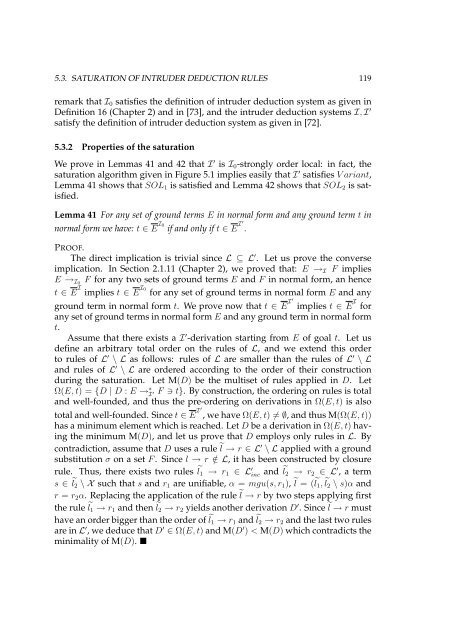Logical Analysis and Verification of Cryptographic Protocols - Loria
Logical Analysis and Verification of Cryptographic Protocols - Loria
Logical Analysis and Verification of Cryptographic Protocols - Loria
Create successful ePaper yourself
Turn your PDF publications into a flip-book with our unique Google optimized e-Paper software.
5.3. SATURATION OF INTRUDER DEDUCTION RULES 119<br />
remark that I0 satisfies the definition <strong>of</strong> intruder deduction system as given in<br />
Definition 16 (Chapter 2) <strong>and</strong> in [73], <strong>and</strong> the intruder deduction systems I, I ′<br />
satisfy the definition <strong>of</strong> intruder deduction system as given in [72].<br />
5.3.2 Properties <strong>of</strong> the saturation<br />
We prove in Lemmas 41 <strong>and</strong> 42 that I ′ is I0-strongly order local: in fact, the<br />
saturation algorithm given in Figure 5.1 implies easily that I ′ satisfies V ariant,<br />
Lemma 41 shows that SOL1 is satisfied <strong>and</strong> Lemma 42 shows that SOL2 is satisfied.<br />
Lemma 41 For any set <strong>of</strong> ground terms E in normal form <strong>and</strong> any ground term t in<br />
normal form we have: t ∈ E I0<br />
if <strong>and</strong> only if t ∈ E I′<br />
.<br />
PROOF.<br />
The direct implication is trivial since L ⊆ L ′ . Let us prove the converse<br />
implication. In Section 2.1.11 (Chapter 2), we proved that: E →I F implies<br />
E →I0 F for any two sets <strong>of</strong> ground terms E <strong>and</strong> F in normal form, an hence<br />
t ∈ E I implies t ∈ E I0<br />
for any set <strong>of</strong> ground terms in normal form E <strong>and</strong> any<br />
ground term in normal form t. We prove now that t ∈ E I′<br />
implies t ∈ E I for<br />
any set <strong>of</strong> ground terms in normal form E <strong>and</strong> any ground term in normal form<br />
t.<br />
Assume that there exists a I ′ -derivation starting from E <strong>of</strong> goal t. Let us<br />
define an arbitrary total order on the rules <strong>of</strong> L, <strong>and</strong> we extend this order<br />
to rules <strong>of</strong> L ′ \ L as follows: rules <strong>of</strong> L are smaller than the rules <strong>of</strong> L ′ \ L<br />
<strong>and</strong> rules <strong>of</strong> L ′ \ L are ordered according to the order <strong>of</strong> their construction<br />
during the saturation. Let M(D) be the multiset <strong>of</strong> rules applied in D. Let<br />
Ω(E, t) = {D | D : E →∗ I ′ F ∋ t}. By construction, the ordering on rules is total<br />
<strong>and</strong> well-founded, <strong>and</strong> thus the pre-ordering on derivations in Ω(E, t) is also<br />
total <strong>and</strong> well-founded. Since t ∈ E I′<br />
, we have Ω(E, t) �= ∅, <strong>and</strong> thus M(Ω(E, t))<br />
has a minimum element which is reached. Let D be a derivation in Ω(E, t) having<br />
the minimum M(D), <strong>and</strong> let us prove that D employs only rules in L. By<br />
contradiction, assume that D uses a rule � l → r ∈ L ′ \ L applied with a ground<br />
substitution σ on a set F . Since l → r /∈ L, it has been constructed by closure<br />
rule. Thus, there exists two rules � l1 → r1 ∈ L ′ inc <strong>and</strong> � l2 → r2 ∈ L ′ , a term<br />
s ∈ � l2 \ X such that s <strong>and</strong> r1 are unifiable, α = mgu(s, r1), � l = ( � l1, � l2 \ s)α <strong>and</strong><br />
r = r2α. Replacing the application <strong>of</strong> the rule � l → r by two steps applying first<br />
the rule � l1 → r1 <strong>and</strong> then � l2 → r2 yields another derivation D ′ . Since � l → r must<br />
have an order bigger than the order <strong>of</strong> � l1 → r1 <strong>and</strong> � l2 → r2 <strong>and</strong> the last two rules<br />
are in L ′ , we deduce that D ′ ∈ Ω(E, t) <strong>and</strong> M(D ′ ) < M(D) which contradicts the<br />
minimality <strong>of</strong> M(D). �
















